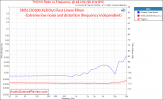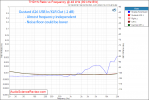There are few reasons for the larger measurement bandwidth to give different THD+N results. Remember that we are looking THD + N, so noise can have a big impact even if there are no out of band harmonics. Many DACs implement noise shaping which results in rising out of band noise, for example here is a measurement from a Focusrite 18i20 2nd gen showing rising noise past 20 kHz.
Even if the noise level is flat from 22 kHz to 90 kHz, because the measurement is being taken over a larger bandwidth the cumulative noise will be greater with the larger bandwidth.
Here are a few examples from a MOTU Ultralite MK5 running at 48 kHz in to a Cosmos ADC running at 384 kHz.
First let's look at a low level signal (-60 dBFS). Here you can see that the noise level is flat from 20 Hz to 100 KHz. The spectrum doesn't change but because noise is being integrated over a larger bandwidth SNR goes down.
1) 22 kHz BW - SNR at -60 dBFS = 61.5 dB, FS SNR = 61.5 + 60 = 121.5 dB
View attachment 354820
2) 48 kHz BW - SNR at -60 dBFS = 58.6 dB, FS SNR = 58.6 + 60 = 118.6 dB
View attachment 354822
3) 90 kHz BW - SNR at -60 dBFS = 56.2 dB, FS SNR = 56.2 + 60 = 116.2 dB
View attachment 354823
Here are a few examples with the same setup but using a higher level signal (4 V). Here you can see there is now some high frequency junk showing up but it is very low in level. Again the biggest difference here is integrating noise over a larger bandwidth, SNR decreases but THD stays about the same, as a result THD+N gets worse.
1) 22 kHz BW - THD = -116.0 dB, SNR = 108.6 dB, THD+N = -107.9 dB
View attachment 354817
2) 48 kHz BW - THD = -115.4 dB, SNR = 105.3 dB, THD+N = -104.9 dB
View attachment 354818
3) 90 kHz BW - THD = -115.6 dB, SNR = 102.0 dB, THD+N = -101.8 dB
View attachment 354819
Hope this helps.
Michael



